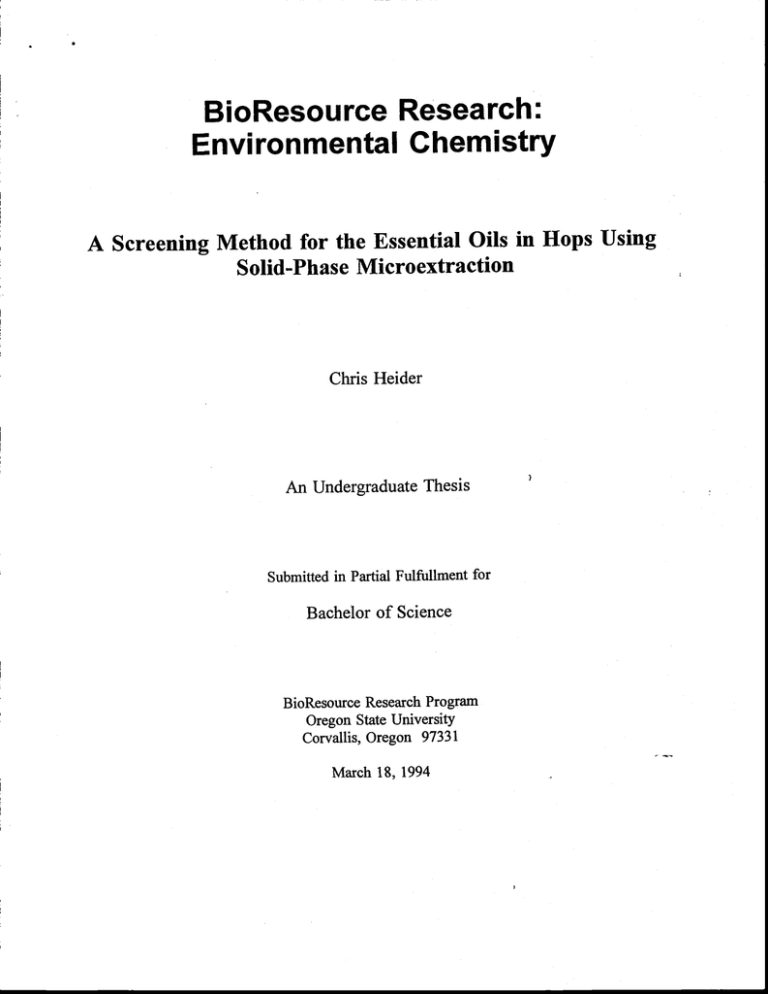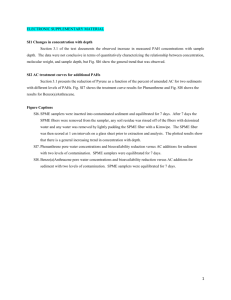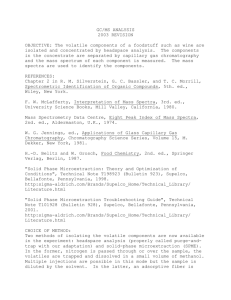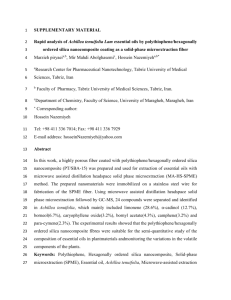Environmental Chemistry BioResource Research: Solid-Phase Microextraction
advertisement

BioResource Research: Environmental Chemistry A Screening Method for the Essential Oils in Hops Using Solid-Phase Microextraction Chris Heider An Undergraduate Thesis Submitted in Partial Fulfullment for Bachelor of Science BioResource Research Program Oregon State University Corvallis, Oregon 97331 March 18, 1994 TABLE OF CONTENTS INTRODUCTION ................................................... Theory ...................................................... Essential Oils ................................... ...... ..... EXPERIMENTAL .................................................. 3 7 9 12 Samples .................................................... 12 Solid-phase microextraction (SPME) ................................ 12 Equilibration ................................................ 13 ......... 14 .................................................... 14 Hop analysis by steam distillation .................................. 14 Gas chromatography ........................................... 14 ................................................ 15 Analytical precision .. Survey Data analysis RESULTS AND DISCUSSION SUMMARY AND FUTURE WORK LITERATURE CITED ........................................ ..................................... ............................................... 16 25 29 INTRODUCTION Separation and isolation of organic analytes from environmental matrices such as soils, water, plant, or animal tissue has traditionally involved the use of liquid solvent extractions. Solvent-based extraction methods are often time-consuming, difficult to automate, and use expensive solvents that generate hazardous waste and working conditions. The need for a rapid, reproducible, inexpensive, environmentally-friendly, and non-destructive technique for sample monitoring and quantitation have promoted the development of newer extraction techniques. Conventional techniques for headspace analysis such as purge and trap have been developed to limit solvent use and increase automation, however this method still requires some use of solvents and sample manipulation. Solid-phase microextraction (SPME) is a rapid, relatively inexpensive, and solvent-frce extraction technique. The apparatus consists of a fused silica fiber, coated with a highly absorbent organic phase, attached to a microsyringe for handling convenience (Figure 1). The extraction procedure involves the exposure of the fiber directly into an aqueous sample or to a sample's headspace. Upon equilibrium between the fiber coating and the sample, the fiber is introduced to the heated inlet of the GC, where the analytes are completely desorbed from the fiber coating'. 2 -a*- Plunger .- Protective sheath -- SPME Filer Figure 1: A model of the SPME device. The advantages of SPME include rapid, solvent-free extractions that require small amounts of sample. In conjunction with ion-trap mass spectrometry, SPME has met (and exceeded) the detection limits set by the conventional methods for environmental contaminants in water such as substituted benzenes, chlorinated aliphatic compounds, and phenols2,3,4,5. Detection limits as low as 15 parts per trillion have been attained with some environmental contaminants by SPME. These low detection limits, in addition to the rapid solvent-free extraction technique, have 3 promoted the investigation of SPME as a substitute for conventional methods used by the U.S. Environmental Protection Agency (EPA) and the Ontario Municipal/Industrial Strategy for Abatement (MISA) program in Canada3'5. Adaptability to be automated6 and the low cost of the SPME device have made SPME a desirable alternative to conventional liquid extractions for environmental contaminants. Although much of the work on SPME has been done with aqueous samples, the versatility of SPME sampling with other systems has not yet been fully explored. A schematic diagram for headspace sampling by SPME is illustrated in Figure 2. A three- phase equilibrium is established among the sample, the headspace, and the fiber coating. Upon equilibrium, the fiber is immediately introduced to the heated inlet of the analytical instrument, where the analytes rapidly desorb from the fiber coating (Figure 3). 4 SPME device S P M E device GC injector 1 ICC column Desorpon Figure 2*: Equilibrium headspace sampling by SPME. *Figures 2 and 3 are adapted from Berg, 1993. 5 Figure 3*: Desorption of analytes from the SPME fiber in the GC injection port. Theory of SPME sampling. The theory of headspace SPME has been developed in full detail by Zhang and Pawliszyn'. Because the total mass of the analyte in the system is constant at all times, one can write an expression for a mass balance among the polymeric fiber coating, the sample matrix, and the headspace as follows: C°V2 = C-IVI + C°°2V2 + C°3V3 (1) Where CO is the initial concentration of the analyte in the matrix and C°°1, C°°2, and C°°3 are the concentrations at equilibrium in the fiber coating, the matrix, and the headspace, respectively, and the volumes of the fiber coating, the matrix, and the headspace are expressed by VI, V2, and V3, respectively. The partition coefficients between the fiber coating and the headspace, and between the headspace and the matrix are described by equations (2) and (3): KI = C°°I / C°°3 K2 = C"3 / C°°2 Fiber coating/ headspace partition coefficient. Headspace/ matrix partition coefficient. (2) (3) The chemical potential (µ) of the analyte in the headspace can be expressed by Nv = µ°(T) + RTIn (pv /p°) (4) where µ,, = Chemical potential of the analyte in the headspace µ°(T) = Chemical potential at standard pressure and temperature (1 atm, 25°C) R = Gas constant T = Temperature of the system pv = Vapor pressure of the analyte in the headspace The chemical potential can likewise be expressed for the matrix (µn,) and fiber coating (µf) with the following equations: µn = µ°(T) + RTIn (Pm /p°) (5) µf = µ°(T) + RTIn (pf /p°) (6) 6 where pm and pf are the vapor pressures of the analyte in the matrix and in the fiber coating, respectively. Henry's Law states the relationship between vapor pressure and concentration:' pf = KF C°°, (7) P. = KH C-2 (8) Where KF and KH are the Henry's constants of the analyte in the fiber coating and in the matrix, respectively. At equilibrium, the chemical potential of the analyte in all three phases is equal, and is expressed by µf=µ=µ,,, (9) Correspondingly, from equations 4, 5, 6, and 9, the vapor pressures must also be equal for each of the three phases at equilibrium. (10) Pf = Pv = Pm Assuming the ideal gas law applies to the analyte in the headspace, PvV3 = nvRT, where n _ number of moles of analyte in the headspace, the following relationship between concentration and vapor pressure exists: (11) Pv = C"3RT Linking equation 11 with equations 7, 8, and 10, the partition coefficients and the Henry's constants demonstrate relationships for the fiber coating/ headspace (K,) and the headspace matrix (K) equilibrium constants: K, = C°°, / C"3 = RT/KF K2 = C°°3 / C°°2 = KH/RT (12) (13) The overall equilibrium constant describing the partitioning between the matrix and the fiber coating is described by 7 K=K1K2=KH/KF (14) As stated earlier, SPME is an equilibrium sampling method. Before a sampling time can be determined, the kinetics of the system leading to equilibrium must be understood. Prior to equilibrium, kinetic limitations exist in the transfer of analytes from the sample to the headspace to the fiber coating'. It is important to understand the factors of the mass transport because improving mass transport decreases the time required to achieve equilibrium. In this study, SPME was investigated as a non-destructive method for monitoring the volatile components that are attributed to the aroma potential in hops. Essential Oils. There are many as 250 chemical constituents that have been identified in the essential oil of a hop9. Two of the more abundant components (Figure 4) in the essential oil are humulene (2,6,6,9-tetramethyl- 1,4,8-cycloundecatriene) and caryophyllene (4,11,11-trimethyl-8methylenebicyclo[7.2.0]undec-4-ene). The compounds are sesquiterpenoid isomers with a molecular weight of 204.36 AMU10. Humulene and caryophyllene have different boiling points and can be distinguished by gas chromatography. Humulene is found mainly in the hop (Humulus lupulis), where caryophyllene occurs in many different plants, especially the essential oil of clove buds (Caryophyllus aromaticus)3. Humulene Carypohyllene Figure 4: Chemical structures of caryophyllene and huumuene. 8 Hops are used for primarily for brewing, where the female cones are added to the "wort" to influence flavor, aroma, and to provide an antiseptic environment for the brew". Both the male flowers and the female cones have glandular sacs called lupulin glands that contain the essential oil9. The females are fertilized by male pollen that is emitted by the male flowers. Because the entire female cone is used in the brewing process and/or ground for analysis, the lupulin glands are opened and its contents become homogenized within the sample. The male flowers, on the other hand, emit only their pollen to the females, not their lupulin glands. So, to determine the particular essential oil qualities of the male for purposes of breeding, the male lupulin glands must be obtained for analysis. For clarity, a "hop" will herein refer to a female hop sample, and "lupulin" will refer to the glands taken from the male hop flowers. Chemical analysis of humulene and caryophyllene in hops is an important procedure in determining the aroma potential of a hop for brewing12. During the brewing process, humulene undergoes oxidation to form epoxides and other oxidation products that contribute to beer aroma 13. Thus, an "aroma hop" is one that contains a significant amount of humulene. Together, humulene and caryophyllene constitute, for all practical purposes, a fixed percent of hop oilla Typically, when a hop has a high concentration of humulene, it has a low concentration of caryophyllene and visa versa. Hop varieties that have been found to have a high (> 3.0) humulene:caryophyllene (H/C) ratio are considered to be good "aroma hops". Lupulin samples with a high H/C ratio exhibit "aroma" characteristics that are beneficial for breeding. Currently, the standard method for determining the components of hop oils involves a 6 hour steam distillation process of a 200 gram hop sample in a large glass distillation apparatus. Manual separations of the oil phase and a 10 percent dilution of the oil in pentane are required 9 to prepare the sample for GC analysis. The method for lupulin analysis is quite crude. An aliquot of pentane is shaken with a lupulin sample. The liquid extract is drawn from the sample and injected into the GC. The lupulin method creates several problems, including buildup of particulates in the GC injector. The methods for obtaining H/C information for multiple hop samples are less than ideal. The use of the large distillation apparatus consumes lab space, time, and resources. A more rapid screening method would provide information as to whether or not a particular variety had the desired characteristics for further oil analysis. Lupulin analysis could benefit from a screening method that does not promote injector and column build-up. The object of this work was to determine if headspace SPME could be used as a viable rapid screening method for determining the H/C ratios of hop and lupulin samples. Fiber desorption time in the inlet, temperature influences on equilibrium time, internal mixing of the system, and the time required for the fiber to achieve equilibrium among the three phases (hop matrix, headspace, and fiber coating) were investigated. The optimal conditions for sampling were established, and the precision of SPME measurements was determined. A survey of several varieties of hops and a male lupulin sample was conducted using the SPME method. The H/C ratio for each female hop sample was determined and compared with that acquired by steam distillation. Conclusions were drawn based on the method precision and "accuracy" as compared with the steam distillation data. Finally, future work that is required to further understand the fundamental parameters involved with the partition coefficients Kl and K2 are discussed. 10 EXPERIMENTAL Samples. All hop samples were obtained from the Hops Research Laboratory, Oregon State University. The hops were grown at USDA-Agricultural Research Service (ARS) hop farm. At harvest, the hops were machine picked, dried 14 h at 50°C, and rehumidified to an 8% moisture content. Samples were compressed into miniature 8" x 6" x 4" bales (12-16 lbs/in.) and stored at -4°C until ground for analysis. The hop varieties used for this project were #9046-049, #9045-036, #60015 Arizona, and #21403 Sticklebract. The commercial sample (Cascade #93261) was dried, pelletized and vacuum packed. The pelletized hop was repulverized with a mortar and pestle and stored in a sealed jar at -4°C. It should be noted the particle size of the pelletized hop was significantly smaller than the ground hop samples. The male lupulin sample (#21362M) was prepared by slurring dried male flowers in water and pouring the slurry through 28, 80, and 200 mesh screens. The lupulin was washed off of the 200 mesh screen with water, dried on filter paper at ambient temperature, and stored at -4°C. Solid-phase microextraction (SPME). In brief, the fiber device is composed of a fused-silica fiber, coated (to a 100µm thickness) with an absorbent organic polymer (Supelco, Bellefonte, PA). The fiber is attached to a plunger on a microsyringe inside a protective sheath for handling convenience (Figure 1). The fiber is exposed to the headspace of a sealed vial containing the sample for a set period of time, wherein the analytes in the headspace are absorbed into the fiber coating. After exposure, the fiber is quickly retracted into the sheath and immediately introduced to the heated inlet of the GC whereupon the fiber is re-exposed. The analytes are quickly desorbed from the fiber coating in the inlet and transferred to the GC column for separation. The time for complete desorption of analytes from the fiber coating was determined by 11 introducing the fiber to the headspace of 2 mL vials containing -50 mg of ground hop for 10 min at 50°C, with no internal stirring or agitation. Desorption of the analytes in the heated inlet of the GC was investigated by varying the exposure time of the fiber in the inlet for periods ranging from 30 s to 3 min. Following the first desorption event, the fiber was re-exposed to the inlet for a second 3 min desorption period to constitute a "blank" run. The time at which complete desorption of the analyte occurred was determined by the absence of humulene and caryophyllene in the subsequent "blank" runs. The effect of temperature on the amount of humulene and caryophyllene absorbed by the fiber was investigated using a set fiber equilibration time of 30 min and desorption time of 3 min. Single samples were individually prepared and sampled at 25, 50, and 70°C. Area counts for humulene and caryophyllene were normalized to the mass of the sample. The H/C ratios for each sample were compared with the HIC ratios found by steam distillation. Three weighed samples (#93261 Cascade) were prepared and individually sampled by SPME under different agitation and mixing regimes. All vials were samples by headspace SPME at 50°C for 30 min. One vial was subjected to sonication, one to a magnetic micro stir-bar, and the third was left as a control with no internal mixing. Equilibration experiments. A group of experiments were designed to determine the length of time to needed for equilibrium sampling. Weighed samples (-'50 mg) of #93261 Cascade were prepared individually and sealed in autosampler vials. The vials were placed in a heat bath (50°C) and the fiber was immediately introduced to the headspace of the vial. The SPME fiber was exposed to individual samples for a total of 5, 10, 30, 45 min, 1, 4, and 24 h. The area counts recorded were normalized to the mass of the sample. 12 A second study was conducted to determine the conditions necessary to achieve equilibrium using a sample that has been allowed to pre-equilibrate at 50°C in the absence of the SPME fiber. Each sample was individually prepared and sampled, and allowed to pre-equilibrate in the sealed vial for a period greater than or equal to 4 hours. Following pre-equilibration, the fiber was introduced to individual vials for periods of 5, 10, 30, 45 min., 1, 1.5, 2, 6, 12, and 24 h. The area counts of humulene and caryophyllene were normalized to the mass of each sample. Analytical precision. Using a sample equilibration time greater than 4 h, a fiber sampling time greater than 6 h at 50°C, and a desorption time in the GC inlet of 3 min, six individually prepared samples of #93261 Cascade were analyzed by headspace SPME. The precision of the six replicate samples was determined by averaging the H/C ratios and calculating the standard deviation. The relative standard deviation (RSD) was found by dividing the standard deviation by the average. Survey of hop and lupulin samples. Duplicates of five hop samples (#93261 Cascade, #9046049, #9045-036, #60015 Arizona, and #21403 Sticklebract) and a male lupulin sample #21362M were analyzed by headspace SPME. The sampling conditions were identical to those given in the Precision section. Hop analysis by steam distillation. All steam distillation data were acquired by Gail Nickerson in the Hops Research Laboratory at Oregon State University. The 200 g hop samples were distilled in water for 6 h; the extracts were diluted 10 x with pentane and analyzed by liquid injection by GC. Gas chromatography. All hop and lupulin samples were analyzed using a 5890A Hewlett- Packard gas chromatograph with a flame ionization detector (FID) and a 30 m X 025 mm W. 13 Supelcowax 10 column with a film thickness of 0.25 microns. The injection port temperature was 200°C and the detector temperature was 250°C. Fiber desorption was performed manually under split (67:1) injection conditions. Helium was used as the carrier gas at 68 mL/min to give a total flow through the column of approximately 1 mL/min. An initial oven temperature of 100°C was maintained for 1.0 min. The oven was then ramped at 5°C/min to a fmal temperature of 240°C, which was maintained for 26 min. The total oven program was 55 minutes. All GC data were collected with a Hewlett Vectra 386 computer using HP 3365 GC Chemstation software. Data analysis. The area counts for humulene and caryophyllene were determined by GC/FID and were normalized to the mass of each sample. The H/C ratio was calculated by diving by the area counts. The H/C ratios obtained by steam distillation (and conventional lupulin analysis) were determined in a manner similar to that for SPME. 14 RESULTS AND DISCUSSION A typical GC/FID chromatogram for hops sampled by SPME is shown in figure 5. Humulene and caryophyllene gave retention times of 19.3 and 17.5 min., respectively. Other major peaks present in the essential oil from female hops are myrcene (8.5 min) and farnesene (18.4 min); some of the minor peaks that are visible are 2-undecanone (16.8 min) and aromadendrene (19.5 min)". Fiber desorption experiments demonstrated that the loss of analyte to the heated inlet of the GC was a rapid process, with complete desorption (i.e. no remnant humulene or caryophyllene peaks found in subsequent blank runs) within 45 s. The desorption time chosen for subsequent method development was 3 min. Although complete desorption of analytes from the fiber coating occurred in 45 s, the 3 min desorption time was chosen to accommodate the potential for a significant amount of extra mass that could be absorbed into the coating with the equilibration experiments over long periods of time. Furthermore, it is recommended by Supelco that the fiber exposure in the inlet should be at least 3 minutes to ensure complete desorption15 As explained in the theory of headspace sampling, temperature influences the chemical potential (t) of the system. Therefore, the volatilization of the analytes into the headspace of the vial is dependant on temperature. Figure 6 exhibits the normalized area counts per unit mass for three different temperatures. For a 30 min fiber exposure (using a 3 min desorption time in the GC inlet), both the overall area counts and the H/C ratios increased with temperature. However, previous headspace analyses of hop oils have shown that temperature increases promoted oxidation of the components (including humulene and caryophyllene)16. Thus, to ensure analyte volatilization and minimize oxidative degradation over long sampling times, a sampling 15 0 5 10 15 20 25 30 35 40 Retention Tim (Win) Figure 5: Chranatogram of #93261 Cascade by headspace SPNE. Humulene (H) and caryophyllene (C) are labelled. 16 45 50 0 temperature of 50°C was chosen. 4.00E+06 Stirring Sonication None 0.00E+00 26.7 50 50 50 70 Temp. (C) H resp C Resp Figure 6: SPME sampling of #93261 Cascade over different temperatures. Note that mixing and sonication were done only at 50°C. A set of experiments designed to overcome the kinetic limitations of analyte mass transfer were conducted. Fiber exposure time was 30 min, desorption time was 3 min, and the temperature was 50°C. Three individual vials were sampled while being subjected to sonication, stirring (with a micro stir-bar), and no internal mixing or sonication as a control (Figure 6). Both stirring of the matrix and sonication exhibited a minor increase in the normalized area counts as compared with the control. Although these experiments used a pelletized hop (#93261 Cascade) and, as a result, the particle size was minimized, mixing and agitation had no effect in improving 17 the H/C ratio. Therefore, mixing and sonication were not used in subsequent SPME sample analyses. An experiment was conducted to determine the time at which equilibrium was reached among the three phases. The fiber was immediately introduced to the headspace and sampled at 50°C for a range of exposure times. Over time, the area counts for humulene and caryophyllene increased before achieving equilibrium at 4 h (Figure 7). The kinetic region of the equilibrium curve is quite evident from fiber exposure times less than 4 hours. The H/C ratios calculated from data in Figure 7 follow a similar behavior, indicating that equilibrium was established after a period of 4 hours (Figure 8). Blank injections were periodically done and showed no carryover from sample to sample. 6.0E+06 + co 4.0E+06 + --------------------------------------------------a U ------x------------------------------------------ 2 OE+06 O.OE+OO 0 4 12 8 16 20 24 Exposure time (h) + H resp x C Resp Figure 7: SPME sampling over time with single samples (#93261 Cascade). The area counts were normalized to sample mass for both humulene (H) and caryophyllene (C). 18 3 2.8 -------------------------------------------------------------2.6 +------------------------------------------------------------- 2.4 ------ ----------------------------------------------------- 2.2 ----------------------------------------------------------- W 0 12 8 16 20 24 Exposure time (h) Figure 8: H/C ratios calculated from Figure 7. A separate equilibration study was conducted by allowing the samples to pre-equilibrate in the vial for a period greater than 4 h before the fiber was introduced. The intent was to separate the components of the three-phase equilibrium. Although the sample had been allowed to pre-equilibrate, the subsequent introduction of the fiber forced the system to re-equilibrate among the three phases. The normalized area counts for both humulene and caryophyllene versus fiber sampling time (50°C, 3 min desorption) are displayed in Figure 9. It is apparent that the 19 area counts, along with the calculated H/C ratios (Figure 10), follow the same trends in achieving equilibrium at a time greater than 4 h. The H/C ratio found by SPME at equilibrium shows a 95 percent agreement with that obtained by steam distillation. This evidence supports the theory that accurate SPME sampling can only be done at equilibrium, and that the fiber must be exposed to the headspace of the hop sample for a period greater than 4 h. A sampling time greater than 6 hours was chosen for future SPME analyses with hops to ensure that equilibrium was established prior to GC analysis. 0.0E+00 T ----- V----------------------------------------------V V V V tjy---------------------------------------------------- 0.0E+00 0 5 10 15 20 25 Exposure time (h) v H resp - C Resp Figure 9: Fiber equilibration over time using pre-heated vials of sample #93261 Cascade. Response is normalized to the mass of the sample. 20 3 2.8 -F------------------------------------------------------------- U 2.4 -- ------------------------------------------------------ 2.2 + 2 1TTIT1--}-1-1 0 4 8 12 16 20 24 Exposure time (h) Figure 10: H/C ratios calculated from data ill Figure 9. The difference in normalized area counts between Figures 7 and 9 is due to experimental difficulties that resulted in a GC column change. The qualitative trends of the data for each can be compared, but any quantitative comparisons about the overall responses cannot be made because of the column differences. Replicates of #93261 Cascade were conducted using the final experimental conditions. The six individually prepared samples gave an average H/C ratio of 2.58 and a standard deviation of 0.06, to give a relative standard deviation (RSD) of 2.3 percent (Table 1). 21 Table I: Replicates of #93261 Cascade performed with a >_ 6 hour fiber exposure at 50°C and a 3 min desorption in GC inlet (200°C). Percent agreement is determined by a percent of the H/C ratio found by steam distillation (2.71). SPME % Agreement with H/C Steam Distillation 1 2.64 97.6 2 2.63 97.2 3 2.66 98.4 4 2.52 93.0 5 2.51 92.8 6 2.53 93.3 Mean 2.58 ± 0.06 95.4 ± 2.6 Sample No. The average agreement of SPME headspace analysis with that of steam distilled data is 95.4 percent. The good agreement in H/C ratios as well as the simple, non-destructive, solvent free extraction method SPME offers is advantageous for screening many samples of hops for H/C ratios. A survey several different hop samples was conducted to test how headspace SPME compares with steam distillation in the determination of H/C ratios. One male lupulin sample was chosen as an expansion of the method to determine if a very different kind of matrix could also 22 be sampled by headspace SPME. It was found that there was good agreement (86-130%) for all of the samples (Table 2). Because the samples were ran in duplicate, the standard deviation from the precision mean was applied. Table 2: Hop survey examining H/C ratios by headspace SPME and steam distillation (S.D.). Percent agreement was based on the H/C ratio obtained from steam distilled oils. Sample SPME Steam Distillation %Agreement with H/C H/C Steam Distillation 9046- 049 274/93 3.01 ± 0.08 3.49 86.3 9045-036 237/93 2.24 ± 0.06 2.43 92.2 #93261 Cascade 2.58 ± 0.06 2.71 95.3 #60015 Ariz. 1-3 0.35 ± 0.01 0.27 130 #21403 1.94 ± 0.05 2.09 92.7 3.30 ± 0.082 3.76 87.8 Sticklebract #21362 M 2265 The survey hops and lupulin had several differences than the commercial hop (#93261 Cascade) used for previous experiments. The female hop samples were groand from hop buds; the leaf structure remained visible after grinding. The Cascade hop was a commercial sample that, upon re-pulverization, had a significantly smaller particle size. The larger particle size of 23 the hop samples other than Cascade could have had an effect on the rate at which equilibrium was approached. Nevertheless, the H/C ratios found by SPME were in good agreement with those found by steam distillation. The H/C ratio for the lupulin sample was also in good agreement with that obtained by conventional pentane extraction. 24 SUMMARY AND FUTURE WORK Sampling of components in the hop essential oil by headspace SPME has been shown to closely resemble those performed by a liquid injection. At equilibrium, SPME provided precise measurements of humulene and caryophyllene ratios that were in good agreement with conventional liquid injections from the distilled oils. Advantages of SPME sampling include the non-destructive use of a small sample, a solvent-free extraction, and the quality of data. In addition to data quality, the requirement of few resources (labor and materials), the low cost of the apparatus itself, and its ability to be automated by a special autosampler make SPME a good alternative for the screening of hops or male lupulin for H/C ratios. Designs for future work with developing headspace SPME for the analysis of analytes in a plant matrix include better understandings of the partition coefficients K, and K2 A preliminary experiment was designed to understand the phenomena of partitioning between the fiber coating and the headspace, via direct (gaseous) sampling of the headspace. Because of time limitations, this experiment was not conducted under equilibrium conditions. Although the data gathered was not collected at equilibrium and cannot strictly be used in the calculation of K,, the fiber absorbed at least 10 times the mass as that of gaseous injections for both humulene and caryophyllene without altering the HIC ratio. It would appear that the fiber coating takes an indiscriminate sample of the headspace. Thus, from preliminary experimental data, the partition coefficient (K,) between the fiber coating and the gas phase appears to be high for both humulene and caryophyllene, and the K, partition coefficients for humulene and for caryophyllene are similar (if not equal) in quantity. A true calculation of the K, values for both humulene and caryophyllene could be 25 accomplished by a direct headspace injection of a sample followed by a SPME injection (at proper equilibration). The area counts for humulene for both injections, and the volumes of the gaseous injection and fiber coating could be entered into the following equation: K1H = AfVg / AgVf Where Af = The area counts determined by SPME Ag = The area counts determined by gaseous injection Vf = The volume of the fiber coating Vg = The volume of the gaseous injection to yield a K, value for humulene. Likewise interpretations could be made for caryophyllene (K1c) or any number of compounds found within the matrix. If the K, values are equal for all components involved, then the SPME fiber samples the headspace indiscriminate of mass or vapor tendencies. The limiting factor, then, of the three-phase equilibria existing with the hop matrix, headspace, and the fiber coating could be assumed to be the partition coefficient K2 between the gas phase and the matrix. A method for the determination of K2 for each of the compounds must involve a known amount of mass in the matrix. Since the components of the hop samples analyzed in this study have not been quantitated, an absolute measure of K2 was not possible. A suggested method to further understand the partitioning between the gas phase and the matrix would be a direct "spike" onto a "spent" hop matrix (i.e. a matrix without any components). In reality, to thoroughly dry a hop and release all of the constituents (there are over 250) would change the nature of the matrix. Unlike aqueous samples where a known amount of compound could be spiked into a well mixed system, the simulation of the hop matrix would be exceedingly difficult. To simply spike 26 a known amount of standard over a "spent" hop matrix and hope for uniform distribution within all of the "spent" glandular and cellular tissue may be an inadequate representation of a "control" hop. Headspace SPME over plant matrices shows promise for providing accurate and precise representations of essential oil constituents as compared with conventional methods. Other applications for SPME include future analysis of plant oils for chemotaxonomic purposes, as well as for monitoring oil constituents in ripening fruits and other crops. Many other applications exist for a variety of compounds, especially for those compounds that are capable of volatilizing rapidly from their matrix. 27 ACKNOWLEDGEMENTS We would like to thank Gail Nickerson in Hops Research at Oregon State University for the use of her computer, instrument, lab facilities, and mind. All of the steam distillation data used in this experiment were aquired by Ms. Nickerson. Thanks to Supelco, Inc. for their donation of SPME fibers and holders. 28 LITERATURE CITED 1. Zhang, Z. and J. Pawliszyn. Headspace solid-phase microextraction. Anal. Chem., 1993, 65, 1843. organic 2. Arthur, C.L., K. Pratt, S. Motlagh, and J. Pawliszyn. Environmental analysis of Nov. 1993, contaminants in water using solid-phase microextraction. J High Res. Chem., 15, 741-744. 3. Arthur, C.L., D.W. Potter, K.D. Buchholz, S. Motlagh, and J. Pawliszyn. Solid-phase microextraction for the direct analysis of water: theory and practice. LC/GC, 10(9), 656-661. 4. Potter, D.W. and J. Pawliszyn. Detection of substituted benzenes in water at the pg/mL level using solid-phase microextraction and gas chromatography-ion trap mass spectrometry. J Chromatography, 625 (1992), 247-255. 5. Buchholz, K.D. and J. Pawliszyn. Determination of phenols by solid-phase microextraction and gas chromatographic analysis. Environ. Sci. Technol. 1993, 27, 2844-2848. 6. Arthur, C.L., L.M. Killam, K.D. Buchholz, and J. Pawliszyn. Automation and optimization of Solid-phase microextraction. Anal. Chem., 1992, 64, 1960-1966. 7. Berg, J. Practical use of automated solid-phase microextraction. American Laboratory, Nov, 1993, 18-25. 8. Atkins, P.W. Physical Chemistry. 3rd edition. W.H. Freeman and Company: San Francisco, CA. 9. Neve, R.A. HOPS. Chapman & Hall: New York (1991). 10. Windholz, M. (ed). Merck Index. Tenth edition. Merck & Co., Inc. (1983). 11. Papazian, C. The New Complete Joy of Home Brewing. Avon Books: New York (1991). 12. 13. Haunold, A. and G.B. Nickerson. Factors affecting hop production, hop quality, and brewer preference. Brewing Techniques, May/June 1993, 18-24. Peacock, V.E. and M.L. Deinzer. Chemistry of hop aroma in beer. J Am. Soc. Brew. Chem., 1981, 39, 136-141. 29 14. Nickerson, Gail. Oregon State University, Hops Research Laboratory. Personal communication. 15. Supelco, Inc. Data sheet, catalogue No.5-7330. Instructions for the Supelcopsolidphase microextraction fiber holder for manual use, 1993. 16. Sharpe, F.R. and D.R.J. Laws. The essential oil of hops--a review. J. Inst. Brew., March-April 1981, 87, 96-107. 30







